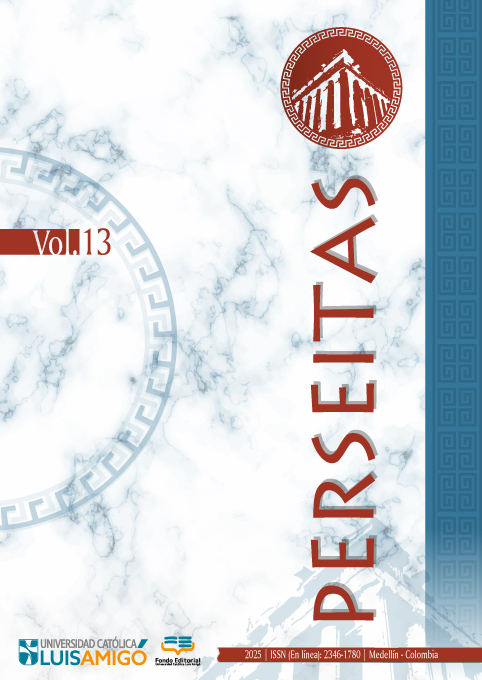Artificial neural networks (ANN) in the light of the relationships between human intelligence and the will in Saint Thomas Aquinas
DOI:
https://doi.org/10.21501/23461780.5006Keywords:
Artificial intelligence, Faculty, Intelligence, Neural networks, Will.Abstract
Human knowledge is a difficult reality to address, as it involves different faculties, both cognitive and appetitive, in which biological and spiritual processes are involved. In recent times, however, human beings have tried to emulate, through computational models, the brain functions that underlie human knowledge. This is what within Artificial Intelligence (AI) has been called artificial neural networks (ANN). Nonetheless, it is necessary to examine to what extent neural networks coincide with human cognitive processes. The objective of this work is to study innovative neural networks in light of the relationships between human intellect and the will in the process of knowledge. We have considered it appropriate to do so from the perspective of Saint Thomas Aquinas because he is an autor who collects, synthesizes and develops the entire classical and medieval cultural heritage around the topic of knowledge.
Downloads
References
Amershi, S., Arksey, N., Carenini, G., Conati, C., Mackworth, A., Maclaren, H., & Poole, D. (2005). Designing CIspace: Pedagogy and usability in a learning environment for AI. ACM Digital Library, 178–182. https://dl.acm.org/doi/10.1145/1151954.1067495
Aquino, T. (1993). Suma teológica. Tomo II. Editorial B.A.C. (Obra original publicada entre 1265 y 1274).
Aquino, T. (1994). Suma teológica. Tomo I. Editorial B.A.C. (Obra original publicada entre 1265 y 1274).
Aquino, T. (1995). Suma teológica. Tomo III. Editorial B.A.C. (Obra original publicada entre 1265 y 1274).
Aquino, T. (1999). Cuestiones disputadas sobre el alma. EUNSA.
Aquino, T. (2002). Comentario a las Sentencias de Pedro Lombardo. El misterio de la trinidad. Vol. I/1. EUNSA. (Obra original publicada en 1252).
Aquino, T. (2005). De Potentia. EUNSA. (Obra original publicada entre 1265 y 1266).
Aquino, T. (2007). Suma contra gentiles. Editorial B.A.C. (Obra original publicada entre 1269 y 1264).
Aquino, T. (2015). Comentario a las Sentencias de Pedro Lombardo. La Creación: ángeles, seres corpóreos, hombre. Vol. II/1. EUNSA.
Aquino, T. (2016). Cuestiones Disputadas Sobre la Verdad. Tomos I-II. EUNSA. (Obra original publicada entre 1256 y 1259).
Astorquiza, P. (2008). Interacción entre la razón y las emociones en el ser humano según Santo Tomás de Aquino. Civilizar, 8(14), 117-132. https://doi.org/10.22518/16578953.757
Brunet, I., Di Nardo, A. A., Sonnier, L., Berdeley, M., & Prochiantz, A. (2007). The topological role of homeoproteins in the developing central nervous system. Trends in Neurosciences, 30(6), 260-7. https://doi.org/10.1016/j.tins.2007.03.010
Castaneda Sanchez, W. A., Polo Escobar, B. R., & Vega Huincho, F. (2023). Artificial neural networks: a measurement of forecast learnings as potential demand. Universidad Ciencia Y Tecnología, 27(118), 51-60. https://doi.org/10.47460/uct.v27i118.686
De Hipona, A. (1958). De Civitate Dei Contra Paganos Libri XXII. Sant’Agostino. (Original escrito entre 412 y 426 d.C.). https://www.augustinus.it/latino/cdd/index2.htm
De Hipona, A. (1956). Tratado sobre la Santísima Trinidad. Biblioteca de Autores Cristianos. (Original publicado alrededor de 417 d.C.)
De Hipona, A. (2022). Obras completas. Biblioteca de Autores Cristianos. https://www.augustinus.it/spagnolo/index.htm
González Salcedo, L. O., Guerrero Zúñiga, A. P., Delvasto Arjona, S., & Ernesto Will, A. L. (2021). Redes neuronales artificiales para estimar propiedades en estado fresco y endurecido, para hormigones reforzados con fibras metálicas. Cuaderno Activa, 9(9), 95–107. https://ojs.tdea.edu.co/index.php/cuadernoactiva/article/view/423
Hall, J. E. (2021). Guyton y Hall. Compendio de fisiología médica. ELSEVIER.
Incio Flores, F. A., Capuñay Sanchez, D. L., Estela Urbina, R. O., Delgado Soto, J. A., & Vergara Medrano, S. E. (2021). Diseño e implementación de una red neuronal artificial para predecir el rendimiento académico en estudiantes de Ingeniería Civil de la UNIFSLB. REVISTA VERITAS ET SCIENTIA–UPT, 10(1), 107–117. https://doi.org/10.47796/ves.v10i1.464
Matich, D. J. (2001). Redes Neuronales: Conceptos Básicos y Aplicaciones. Universidad Tecnológica Nacional. https://www.frro.utn.edu.ar/repositorio/catedras/quimica/5_anio/orientadora1/monograias/matich-redesneuronales.pdf
MathWorks. (s.f.). ¿Qué es una red neuronal? Tres cosas que es necesario saber. https://es.mathworks.com/discovery/neural-network.html
Ocampo Ponce, M. (2019). Aproximación metafísica a la producción de conceptos universales. Revista Chilena de Estudios Medievales, (16), 9-19. https://revistas.ugm.cl/index.php/rcem/article/view/266
Pakkenberg, B., & Gundersen, H.J. (1997). Neocortical neuron number in humans: effect of sex and age. The Journal Comparative Neurology, 384(2), 312-320. https://pubmed.ncbi.nlm.nih.gov/9215725/
Rosales-Reynoso, M. A., Juárez-Vázquez, C. I., & Barros-Núñez, P. (2018). Evolución y genómica del cerebro humano. Neurología, 33(4), 254-265. https://doi.org/10.1016/j.nrl.2015.06.002
Stephan, H., Frahm, H., & Baron, G. (1981). New and Revised Data on Volumes of Brain Structures in Insectivores and Primates. Folia Primatologica, 35(1), 1-29. https://doi.org/10.1159/000155963
Zapata Yance, L. F. (2009). Evolución, cerebro y cognición. Psicología Desde Caribe, (24), 106-119. https://rcientificas.uninorte.edu.co/index.php/psicologia/article/view/616
Downloads
Published
How to Cite
Issue
Section
License

This work is licensed under a Creative Commons Attribution-NonCommercial-NoDerivatives 4.0 International License.
La revista y los textos individuales que en esta se divulgan están protegidos por las leyes de copyright y por los términos y condiciones de la Licencia Creative Commons Atribución-No Comercial-Sin Derivar 4.0 Internacional.
















